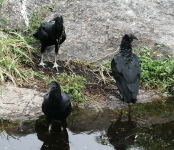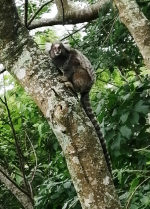Trystan
Well-known member
After a year of cancellations, lockdowns and disappointments, it was looking bleak for maintaining my personal goals of three new countries and 200 new species every year.
With a short trip to Rome, including the Vatican City under my belt, I could at least get the country target if anywhere would have someone from the UK. With the goalposts moving constantly, a number of countries were considered and dismissed.
With the UK once again entering a lockdown in November; nobody allowed to travel for tourism; and no guarantee that travel would be permitted again after the lockdown, there didn’t seem much hope.
I had, however, been in contact with the Itororo lodge in Brazil who put me in touch with Andy Foster at Serra dos Tucanos Birding Tours about arranging a last minute trip should things fall kindly. Brazil, has remained open for tourism with no additional requirements for those travelling from the UK since around August. So if this stayed the same, and the UK came out of lockdown on 2nd December and I could get some insurance to travel to Brazil, and I could time it so that my return quarantine fell over the Christmas period so as not to impact on work, then it might just be possible!
I bought a field guide, Ber van Perlo’s Birds of Brazil, and began revising a little in advance based on the list provided by Andy just in case.
I kept an eye on the flights for my dates. Direct flights to Rio vanished; then flights via Madrid vanished; flights via Amsterdam flew a day too early, but I managed to wrangle the extra day from work if it was to go ahead. Finally, we were out of lockdown; the flight prices doubled overnight! Thanks KLM.
I was able to secure insurance for travel even with the FCDO “essential travel only”, through a company called Battleface. It did not cover everything; but it covered health which was the main requirement for me to commit to the trip so on the 3rd December, I pulled everything together to start out on the 8th for 3 days in Rio, followed by 10 days Atlantic rainforest birding from Itororo lodge.
I had chosen accommodation in Rio, positioned near the canal between Ipanema beach and the big lagoon. Magaridas Pousada apartments which were very nice, with a homely breakfast and highly recommended if staying in Rio. I didn’t know for sure if this would work out well for some casual birding but it seemed the best bet, with the botanical gardens and parque Lage, also within walking distance (About 30 minutes around the lagoon). The latter is the access point to the walking trail to Christ the Redeemer – more about that later.
I arrived on the evening of the 8th, and changed some cash at the airport for a very poor rate, followed by a taxi to my hotel. I had heard lots of horror stories about card cloning using the ATMs, and having to be careful about walking around with phones, cameras etc. In truth, though I did avoid the ATMs, I felt completely safe walking about Rio, obviously staying in the tourist areas around Ipanema, Copacobana, and slightly into Leblon and Botafogo.
There was very little pestering, a quick shake of the head seemed enough to deter people along the beach and the few homeless people present on my morning walks kept themselves to themselves. Not many people spoke English, a few little Portuguese phrases and lots of gesticulating seemed to get me by.
So here’s how it went. New birds for the trip highlighted in bold, lifers in capitals, introduced species in italics throughout the report.
With a short trip to Rome, including the Vatican City under my belt, I could at least get the country target if anywhere would have someone from the UK. With the goalposts moving constantly, a number of countries were considered and dismissed.
With the UK once again entering a lockdown in November; nobody allowed to travel for tourism; and no guarantee that travel would be permitted again after the lockdown, there didn’t seem much hope.
I had, however, been in contact with the Itororo lodge in Brazil who put me in touch with Andy Foster at Serra dos Tucanos Birding Tours about arranging a last minute trip should things fall kindly. Brazil, has remained open for tourism with no additional requirements for those travelling from the UK since around August. So if this stayed the same, and the UK came out of lockdown on 2nd December and I could get some insurance to travel to Brazil, and I could time it so that my return quarantine fell over the Christmas period so as not to impact on work, then it might just be possible!
I bought a field guide, Ber van Perlo’s Birds of Brazil, and began revising a little in advance based on the list provided by Andy just in case.
I kept an eye on the flights for my dates. Direct flights to Rio vanished; then flights via Madrid vanished; flights via Amsterdam flew a day too early, but I managed to wrangle the extra day from work if it was to go ahead. Finally, we were out of lockdown; the flight prices doubled overnight! Thanks KLM.
I was able to secure insurance for travel even with the FCDO “essential travel only”, through a company called Battleface. It did not cover everything; but it covered health which was the main requirement for me to commit to the trip so on the 3rd December, I pulled everything together to start out on the 8th for 3 days in Rio, followed by 10 days Atlantic rainforest birding from Itororo lodge.
I had chosen accommodation in Rio, positioned near the canal between Ipanema beach and the big lagoon. Magaridas Pousada apartments which were very nice, with a homely breakfast and highly recommended if staying in Rio. I didn’t know for sure if this would work out well for some casual birding but it seemed the best bet, with the botanical gardens and parque Lage, also within walking distance (About 30 minutes around the lagoon). The latter is the access point to the walking trail to Christ the Redeemer – more about that later.
I arrived on the evening of the 8th, and changed some cash at the airport for a very poor rate, followed by a taxi to my hotel. I had heard lots of horror stories about card cloning using the ATMs, and having to be careful about walking around with phones, cameras etc. In truth, though I did avoid the ATMs, I felt completely safe walking about Rio, obviously staying in the tourist areas around Ipanema, Copacobana, and slightly into Leblon and Botafogo.
There was very little pestering, a quick shake of the head seemed enough to deter people along the beach and the few homeless people present on my morning walks kept themselves to themselves. Not many people spoke English, a few little Portuguese phrases and lots of gesticulating seemed to get me by.
So here’s how it went. New birds for the trip highlighted in bold, lifers in capitals, introduced species in italics throughout the report.






